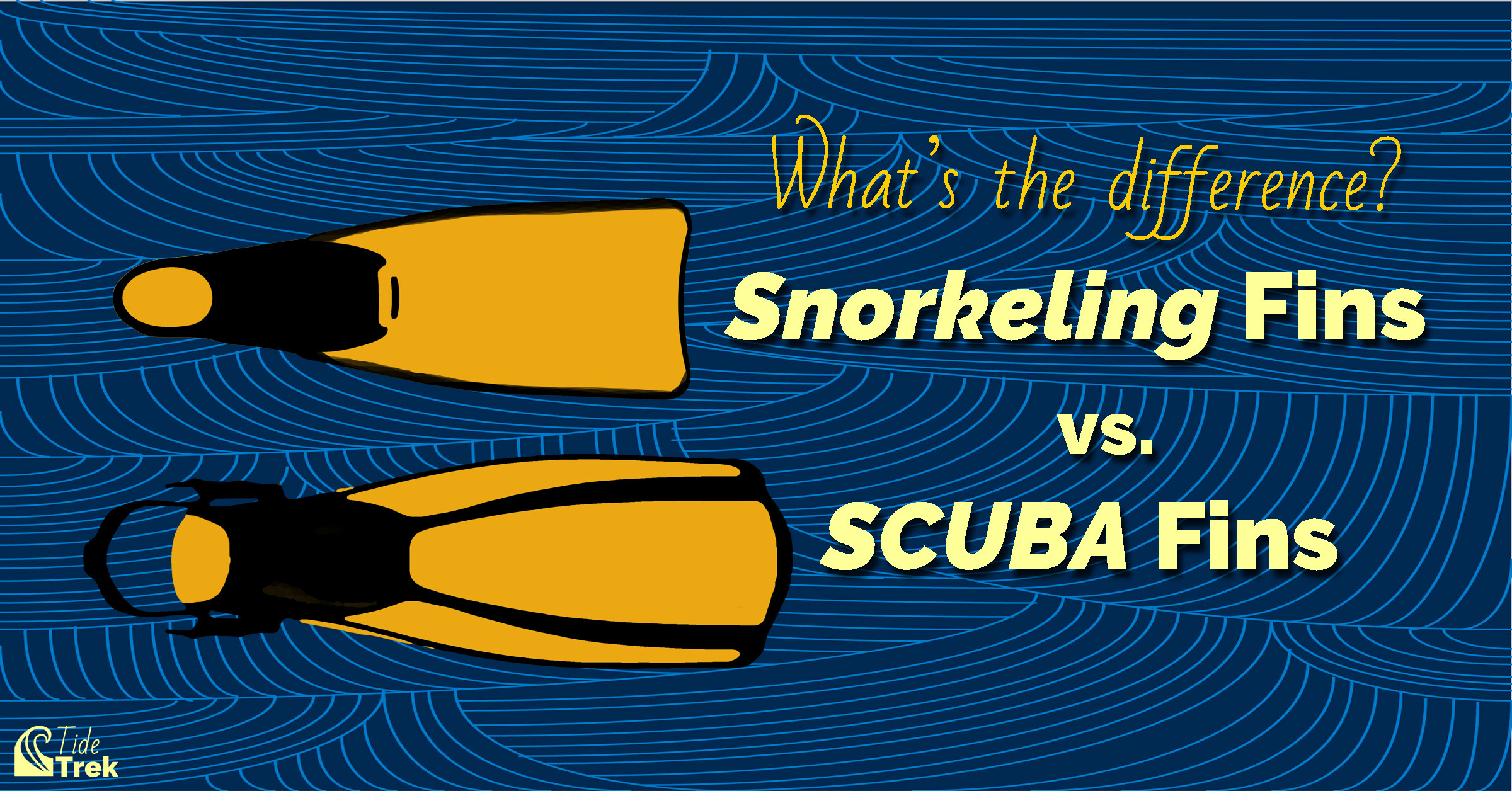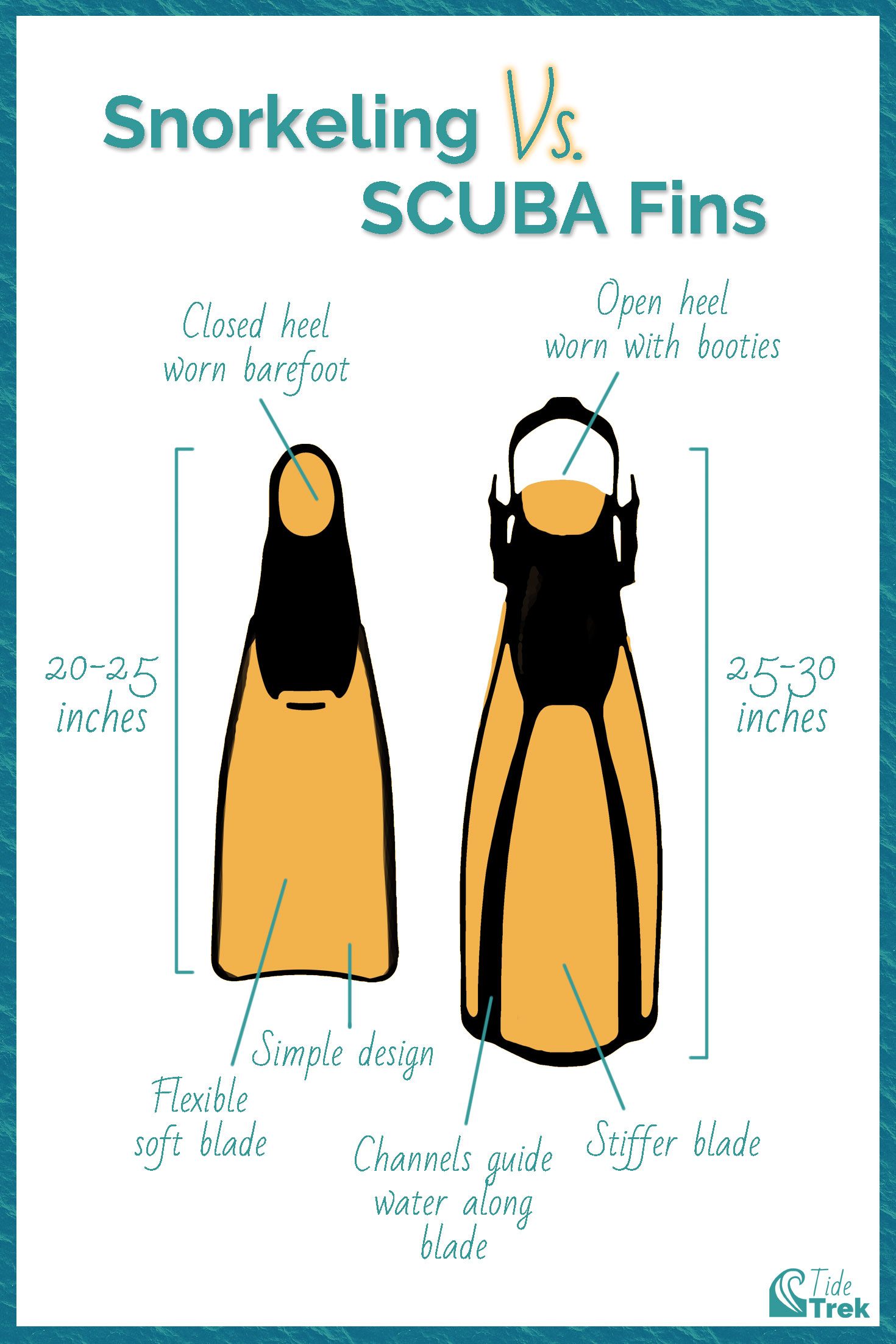
If you’re in the market for a pair of fins to use on your next snorkeling trip, you might be confused about what kind of fin to buy. You should be buying your snorkeling gear at a dedicated dive shop (you can read this article to learn why that is important). However, that means many of the fins you’ll come across will be designed for SCUBA divers, not snorkeling. But isn’t a fin just a fin? What’s the difference between snorkeling and SCUBA fins?
SCUBA fins tend to be longer, stiffer, and bulkier than snorkeling fins. This is because SCUBA divers need fins that can generate higher amounts of thrust. However, SCUBA fins also require a stronger kick than a snorkeling fin because they’re longer and stiffer. Additionally, SCUBA fins are often open-heeled rather than full-foot to accommodate dive boots.
4 Key Differences between snorkeling and SCUBA fins
1. SCUBA fins are longer
As a rough guideline, snorkeling fins will be 20-25 inches long, while SCUBA fins will be 25-30 inches long.
This is because longer fins are better at generating thrust. Now, it’s possible to generate the same thrust with either long or short fins, but longer fins are more efficient at doing so. Simply put, longer fins can move more water with each kick.
Related Post: Long vs. short fins for snorkeling? Which is best?
But what is thrust and why is it important for SCUBA divers?
2. SCUBA fins have better thrust efficiency
Thrust is the force that propels you forward in response to the backward force of your kicks. The more power you generate with your kicks, the greater your thrust. More thrust means greater acceleration and speed.
SCUBA fins are designed to be used at depth and to compensate for all the heavy gear SCUBA divers wear. Longer, bulkier fins are great for propelling you in deep water with weights and a tank strapped to you. But that extra bulk means your legs have to work harder. As a result, SCUBA fins tend to be cumbersome and inefficient for snorkeling. This is especially true if you’re inexperienced and/or have a weak kick.
Because of their stiffness, learning to move finely and precisely with SCUBA fins takes practice. Divers learn to use a variety of techniques beyond the simple flutter kick to maintain control in all kinds of environments. For example, SCUBA divers learn the frog kick for moving through caves and wrecks (or simply moving closely along the sea floor). The helicopter kick lets you turn around in place, and the reverse kick lets you move backward.
3. SCUBA fins have stiffer blades
SCUBA fins tend to be stiffer than snorkeling fins. Not only do SCUBA divers wear heavy equipment, but they are also active at depths where the pressure is greater. A soft, flexible snorkeling fin designed for easy surface swimming will simply not be strong enough to generate the thrust a SCUBA diver needs to move efficiently.
4. SCUBA fins are usually open-heel
Because SCUBA divers do most of their activity at depths far greater than the average snorkeler, they need more insulation as well. Deeper water is colder than surface water! The foot component of a SCUBA diver’s full wetsuit is called a dive boot or bootie. SCUBA divers also need booties for walking while wearing their gear out of the water. Some dive sites can only be accessed by walking over rough or rocky beaches first.
The sole of the foot pocket is particularly inflexible on SCUBA fins relative to snorkeling fins. That rigid foot pocket is both to maximize thrust and accommodate the thick, rubber-sole of the bootie. As such, SCUBA fins tend to be open-heel, so the bootie can easily slide into the foot pocket. The strap of the pocket may also be designed to adjust to changing pressure with depth (compresses and relaxes with the boot’s neoprene).
Most casual snorkelers will be swimming in warm, tropical water, making full-foot pockets the better choice. Full-foot fins also tend to weigh less so they’re easier on your legs (and your luggage!)
Related Post: Open-Heel Vs. Full-Foot Fins (Pros and Cons)



Can you use SCUBA fins for snorkeling or vice versa?
Quick answer: Technically you can, of course, but you shouldn’t.
But what if you want to use your fins for both snorkeling and SCUBA?
If you’re looking for something more versatile, then you’ll want what I call a “Goldilocks” fin. Something longer and stiffer than a fin designed for snorkeling, but not too long or too stiff! Especially if you’re diving in shallower, tropical water without much current, you’ll be able to travel with just one set of versatile fins.
For some recommendations on both full-foot and open-heel fins that fit this “Goldilocks” description, check out my article on snorkeling fins for beginners:
Related Post: Ideal snorkeling fins for beginners



Disclaimer: Some of the links used in this article are affiliate links. That means I may get a small commission if you buy a product after following the link (you can read more about how I use affiliate links here). If you found this article helpful, consider it like giving me a little thank you!
If you want to keep updated on the content I produce here at Tide Trek, please consider signing up to my mailing list. At the end of each month I prepare a little round-up newsletter that summarizes new articles I’ve written, and content I’ve curated covering all things water sports (even some cool marine science too!)
What are your thoughts? Please don't be shy!